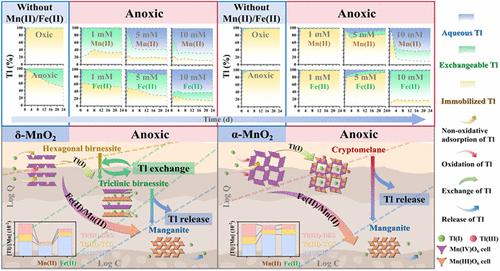MnO2的还原转化控制铊再活化:层状和隧道结构的不同效应
IF 11.3
1区 环境科学与生态学
Q1 ENGINEERING, ENVIRONMENTAL
引用次数: 0
摘要
锰氧化物在表观生物环境中对Tl的清除和积累起着关键作用。然而,Mn/Fe循环中Mn氧化物还原对Tl动员的影响尚不清楚。本文研究了Mn氧化物结构、氧环境和还原程度对MnO2转化和相关Tl物种分布的影响。在氧化环境下,典型的δ-MnO2和α-MnO2结构(分别为层状和隧道状)都能长时间固定Tl(I)。在轻度至中度还原性缺氧环境中,δ-MnO2的剧烈还原转化导致Tl结合,主要以交换形式结合。在高还原环境下,δ-MnO2或α-MnO2转化为锰矿,释放出更多的Tl。Tl- liii边缘x射线吸收光谱表明,氧化态Tl(III)(54-62%)在MnO2的还原转化过程中转化为结构态Tl(I)(67-80%)并结合在层间/隧道中心,增强了δ-MnO2中Tl交换,导致Tl在α-MnO2中固定。研究结果表明,缺氧Tl(I)-/Mn(II)-/Fe(II)诱导的MnO2转化可以增强Tl的动员,隧道MnO2可能比层状MnO2具有更可持续的Tl固定潜力,这提高了对不同Mn相关还原环境中Tl的地球化学行为的总体理解。本文章由计算机程序翻译,如有差异,请以英文原文为准。

Reductive Transformation of MnO2 Controls Thallium Remobilization: Differential Effects of Layered and Tunneled Structures
Mn oxides play a critical role in Tl scavenging and accumulation in the epibiotic environment. However, the effect of Mn oxide reduction in the Mn/Fe cycle on Tl mobilization is not clear. Herein, the influence of Mn oxide configuration, oxygen environment, and degree of reduction on MnO2 transformation and associated Tl species distribution is investigated. In oxic environments, both typical δ-MnO2 and α-MnO2 structures (i.e., layered and tunneled, respectively) can immobilize Tl(I) for a long time. In mild-to-moderate reducing anoxic environments, the drastic reductive transformation of δ-MnO2 results in Tl binding, mainly in an exchangeable form. In highly reducing environments, δ-MnO2 or α-MnO2 is converted to Manganite, resulting in the release of more Tl. Tl-LIII edge X-ray absorption spectroscopy indicates that oxidized Tl(III) (54–62%) is converted to structural Tl(I) (67–80%) and bound to interlayer/tunnel centers during the reductive transformation of MnO2, which enhances Tl exchange in δ-MnO2 and leads to Tl immobilization in α-MnO2. Our results show that anoxic Tl(I)-/Mn(II)-/Fe(II)-induced MnO2 transformation can enhance Tl mobilization, and tunneled MnO2 may have a more sustainable Tl immobilization potential than layered MnO2, which improves the general understanding of the geochemical behavior of Tl in different Mn-related reducing environments.
求助全文
通过发布文献求助,成功后即可免费获取论文全文。
去求助
来源期刊

环境科学与技术
环境科学-工程:环境
CiteScore
17.50
自引率
9.60%
发文量
12359
审稿时长
2.8 months
期刊介绍:
Environmental Science & Technology (ES&T) is a co-sponsored academic and technical magazine by the Hubei Provincial Environmental Protection Bureau and the Hubei Provincial Academy of Environmental Sciences.
Environmental Science & Technology (ES&T) holds the status of Chinese core journals, scientific papers source journals of China, Chinese Science Citation Database source journals, and Chinese Academic Journal Comprehensive Evaluation Database source journals. This publication focuses on the academic field of environmental protection, featuring articles related to environmental protection and technical advancements.
 求助内容:
求助内容: 应助结果提醒方式:
应助结果提醒方式:


